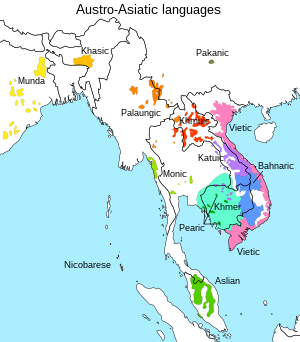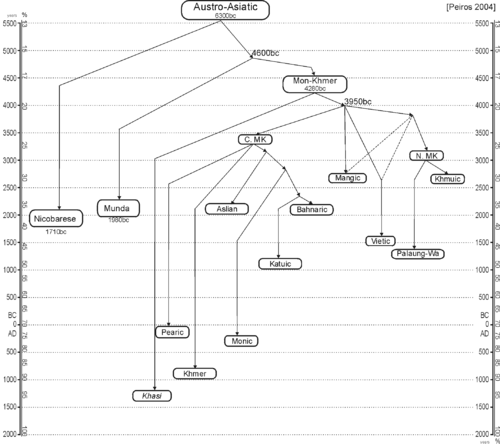
A | B | C | D | E | F | G | H | CH | I | J | K | L | M | N | O | P | Q | R | S | T | U | V | W | X | Y | Z | 0 | 1 | 2 | 3 | 4 | 5 | 6 | 7 | 8 | 9
| Austroasiatic | |
|---|---|
| Austro-Asiatic | |
| Geographic distribution | Southeast, South and East Asia |
| Linguistic classification | One of the world's primary language families |
| Proto-language | Proto-Austroasiatic |
| Subdivisions | |
| ISO 639-5 | aav |
| Glottolog | aust1305 (Austroasiatic) |
 | |
The Austroasiatic languages[note 1] (/ˌɒstroʊ.eɪʒiˈætɪk, ˌɔː-/ OSS-troh-ay-zhee-AT-ik, AWSS-) are a large language family spoken throughout Mainland Southeast Asia, South Asia and East Asia. These languages are natively spoken by the majority of the population in Vietnam and Cambodia, and by minority populations scattered throughout parts of Thailand, Laos, India, Myanmar, Malaysia, Bangladesh, Nepal, and southern China. Approximately 117 million people speak an Austroasiatic language, of which more than two-thirds are Vietnamese speakers.[1] Of the Austroasiatic languages, only Vietnamese, Khmer, and Mon have lengthy, established presences in the historical record. Only two are presently considered to be the national languages of sovereign states: Vietnamese in Vietnam, and Khmer in Cambodia. The Mon language is a recognized indigenous language in Myanmar and Thailand, while the Wa language is a "recognized national language" in the de facto autonomous Wa State within Myanmar. Santali is one of the 22 scheduled languages of India. The remainder of the family's languages are spoken by minority groups and have no official status.
Ethnologue identifies 168 Austroasiatic languages. These form thirteen established families (plus perhaps Shompen, which is poorly attested, as a fourteenth), which have traditionally been grouped into two, as Mon–Khmer,[2] and Munda. However, one recent classification posits three groups (Munda, Mon-Khmer, and Khasi–Khmuic),[3] while another has abandoned Mon–Khmer as a taxon altogether, making it synonymous with the larger family.[4]
Austroasiatic languages appear to be the extant autochthonous languages in mainland Southeast Asia, with the neighboring Kra–Dai, Hmong-Mien, Austronesian, and Sino-Tibetan languages having arrived via later migrations.[5]
Etymology
The name Austroasiatic was coined by Wilhelm Schmidt (German: austroasiatisch) based on auster, the Latin word for "South" (but idiosyncratically used by Schmidt to refer to the southeast), and "Asia".[6] Despite the literal meaning of its name, only three Austroasiatic branches are actually spoken in South Asia: Khasic, Munda, and Nicobarese.
Typology
Regarding word structure, Austroasiatic languages are well known for having an iambic "sesquisyllabic" pattern, with basic nouns and verbs consisting of an initial, unstressed, reduced minor syllable followed by a stressed, full syllable.[7] This reduction of presyllables has led to a variety of phonological shapes of the same original Proto-Austroasiatic prefixes, such as the causative prefix, ranging from CVC syllables to consonant clusters to single consonants among the modern languages.[8] As for word formation, most Austroasiatic languages have a variety of derivational prefixes, many have infixes, but suffixes are almost completely non-existent in most branches except Munda, and a few specialized exceptions in other Austroasiatic branches.[9]
The Austroasiatic languages are further characterized as having unusually large vowel inventories and employing some sort of register contrast, either between modal (normal) voice and breathy (lax) voice or between modal voice and creaky voice.[10] Languages in the Pearic branch and some in the Vietic branch can have a three- or even four-way voicing contrast.
However, some Austroasiatic languages have lost the register contrast by evolving more diphthongs or in a few cases, such as Vietnamese, tonogenesis. Vietnamese has been so heavily influenced by Chinese that its original Austroasiatic phonological quality is obscured and now resembles that of South Chinese languages, whereas Khmer, which had more influence from Sanskrit, has retained a more typically Austroasiatic structure.
Proto-language
Much work has been done on the reconstruction of Proto-Mon–Khmer in Harry L. Shorto's Mon–Khmer Comparative Dictionary. Little work has been done on the Munda languages, which are not well documented. With their demotion from a primary branch, Proto-Mon–Khmer becomes synonymous with Proto-Austroasiatic. Paul Sidwell (2005) reconstructs the consonant inventory of Proto-Mon–Khmer as follows:[11]
| Labial | Alveolar | Palatal | Velar | Glottal | ||
|---|---|---|---|---|---|---|
| Plosive | voiceless | *p | *t | *c | *k | *ʔ |
| voiced | *b | *d | *ɟ | *ɡ | ||
| implosive | *ɓ | *ɗ | *ʄ | |||
| Nasal | *m | *n | *ɲ | *ŋ | ||
| Liquid | *w | *l, *r | *j | |||
| Fricative | *s | *h | ||||
This is identical to earlier reconstructions except for *ʄ. *ʄ is better preserved in the Katuic languages, which Sidwell has specialized in.
Internal classification
Linguists traditionally recognize two primary divisions of Austroasiatic: the Mon–Khmer languages of Southeast Asia, Northeast India and the Nicobar Islands, and the Munda languages of East and Central India and parts of Bangladesh and Nepal. However, no evidence for this classification has ever been published.
Each of the families that is written in boldface type below is accepted as a valid clade.[clarification needed] By contrast, the relationships between these families within Austroasiatic are debated. In addition to the traditional classification, two recent proposals are given, neither of which accepts traditional "Mon–Khmer" as a valid unit. However, little of the data used for competing classifications has ever been published, and therefore cannot be evaluated by peer review.
In addition, there are suggestions that additional branches of Austroasiatic might be preserved in substrata of Acehnese in Sumatra (Diffloth), the Chamic languages of Vietnam, and the Land Dayak languages of Borneo (Adelaar 1995).[12]
Diffloth (1974)
Diffloth's widely cited original classification, now abandoned by Diffloth himself, is used in Encyclopædia Britannica and—except for the breakup of Southern Mon–Khmer—in Ethnologue.
- Austro‑Asiatic
Peiros (2004)
Peiros is a lexicostatistic classification, based on percentages of shared vocabulary. This means that languages can appear to be more distantly related than they actually are due to language contact. Indeed, when Sidwell (2009) replicated Peiros's study with languages known well enough to account for loans, he did not find the internal (branching) structure below.

- Austro‑Asiatic
Diffloth (2005)
Diffloth compares reconstructions of various clades, and attempts to classify them based on shared innovations, though like other classifications the evidence has not been published. As a schematic, we have:
| Austro‑Asiatic | |
Or in more detail,
- Austro‑Asiatic
- Munda languages (India)
- Koraput: 7 languages
- Core Munda languages
- Kharian–Juang: 2 languages
- North Munda languages
- Korku
- Kherwarian: 12 languages
- Khasi–Khmuic languages (Northern Mon–Khmer)
- Khasian: 3 languages of north eastern India and adjacent region of Bangladesh
- Palaungo-Khmuic languages
- Nuclear Mon–Khmer languages
- Khmero-Vietic languages (Eastern Mon–Khmer)
- Vieto-Katuic languages ?[13]
- Vietic: 10 languages of Vietnam and Laos, including Muong and Vietnamese, which has the most speakers of any Austroasiatic language.
- Katuic: 19 languages of Laos, Vietnam, and Thailand.
- Khmero-Bahnaric languages
- Vieto-Katuic languages ?[13]
- Nico-Monic languages (Southern Mon–Khmer)
- Nicobarese: 6 languages of the Nicobar Islands, a territory of India.
- Asli-Monic languages
- Aslian: 19 languages of peninsular Malaysia and Thailand. Zdroj:https://en.wikipedia.org?pojem=Austro-Asiatic_people_of_South_Asia
Text je dostupný za podmienok Creative Commons Attribution/Share-Alike License 3.0 Unported; prípadne za ďalších podmienok. Podrobnejšie informácie nájdete na stránke Podmienky použitia.
- Khmero-Vietic languages (Eastern Mon–Khmer)
- Munda languages (India)
Antropológia
Aplikované vedy
Bibliometria
Dejiny vedy
Encyklopédie
Filozofia vedy
Forenzné vedy
Humanitné vedy
Knižničná veda
Kryogenika
Kryptológia
Kulturológia
Literárna veda
Medzidisciplinárne oblasti
Metódy kvantitatívnej analýzy
Metavedy
Metodika
Text je dostupný za podmienok Creative
Commons Attribution/Share-Alike License 3.0 Unported; prípadne za ďalších
podmienok.
Podrobnejšie informácie nájdete na stránke Podmienky
použitia.
www.astronomia.sk | www.biologia.sk | www.botanika.sk | www.dejiny.sk | www.economy.sk | www.elektrotechnika.sk | www.estetika.sk | www.farmakologia.sk | www.filozofia.sk | Fyzika | www.futurologia.sk | www.genetika.sk | www.chemia.sk | www.lingvistika.sk | www.politologia.sk | www.psychologia.sk | www.sexuologia.sk | www.sociologia.sk | www.veda.sk I www.zoologia.sk
